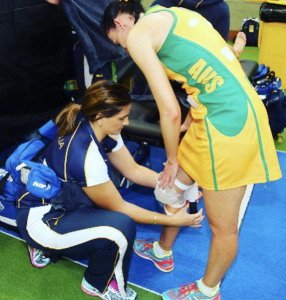Sports Injury Physiotherapy
Article by Zoe Russell

What is Sports Injury Physiotherapy?
Sports injury physiotherapy is a specialised branch of physiotherapy that focuses on treating and preventing injuries related to sports and exercise. This field combines an in-depth knowledge of human anatomy and physiology with an understanding of the demands of different sports to create tailored treatment plans. These plans not only target immediate pain and dysfunction but also aim to enhance overall athletic performance and prevent future injuries.
Why Do Athletes Need Sports Injury Physiotherapy?
In the competitive world of sports, athletes face a high risk of injury, whether during intense matches or routine training sessions. Injuries can disrupt an athlete’s progress, but timely physiotherapy can help them recover faster and more effectively. By addressing both the physical and mental aspects of recovery, sports injury physiotherapy ensures that athletes return to their peak condition, reducing the chances of re-injury.

How Does Sports Injury Physiotherapy Work?
Sports injury physiotherapy starts with a thorough assessment of the injury, including understanding its cause, severity, and impact on the athlete’s body. Treatment often begins soon after the injury, typically within a few days, once acute symptoms like severe pain and swelling have subsided. Early intervention is crucial as it involves gentle, controlled movements to reduce pain and promote healing. As the recovery progresses, the physiotherapist gradually introduces more challenging exercises, focusing on restoring strength, flexibility, and range of motion.
What are the Stages of Rehabilitation?
Rehabilitation from sports injuries generally follows a structured process:
- Acute Phase: Focuses on reducing pain and swelling using methods like rest, ice, compression, and elevation (RICE). Gentle mobilisation exercises are introduced to prevent stiffness.
- Recovery Phase: As pain and swelling decrease, the focus shifts to restoring range of motion, strength, and flexibility. Exercises become more specific to the athlete’s sport and individual needs.
- Reconditioning Phase: The final phase involves sport-specific exercises and drills aimed at returning the athlete to their pre-injury level. This stage ensures that the injury is fully healed and that the athlete regains confidence in their body.
Why is Rehabilitation Important After Sports Injuries?
Rehabilitation after sports injuries is not just about physical recovery. It also addresses the mental and psychological aspects of returning to sport. Techniques such as therapeutic exercises, manual therapy, sports massage, and injury prevention education are used to prepare athletes to safely return to their sport. The goal is to ensure they perform at their best while minimising the risk of future injuries.
FAQs on Sports Injury Physiotherapy
- Why is sports injury physiotherapy important?
- It speeds up recovery and prevents future injuries.
- How soon after an injury should physiotherapy begin?
- Ideally within a few days, once acute symptoms subside.
- What does sports injury physiotherapy involve?
- A combination of therapeutic exercises, manual therapy, and injury prevention education.
- Who benefits from sports injury physiotherapy?
- Athletes of all levels, from amateur to professional.
- Where can I find a sports injury physiotherapist?
- Consult your local clinic or healthcare provider.
- When can I return to sport after physiotherapy?
- This depends on the injury and individual progress, typically after completing the reconditioning phase.
- What is the cost of sports injury physiotherapy?
- Costs vary depending on the clinic and treatment plan.
- Why should I choose sports injury physiotherapy over general physiotherapy?
- It’s tailored to the specific demands of your sport and injury.
- How can I prevent sports injuries?
- Through proper training, warm-ups, and regular physiotherapy check-ups.
- What role does mental recovery play in sports injury physiotherapy?
- It’s crucial for rebuilding confidence and ensuring a full return to sport.
Conclusion: Take the Next Step
In the world of sports, injuries are inevitable, but they don’t have to end an athlete’s career. Sports injury physiotherapy provides a clear path to recovery, addressing both physical and psychological challenges. If you’re dealing with a sports injury, consult a physiotherapist today. With professional guidance, you can regain your strength and return to your sport with confidence.

What to Do? Seek Professional Advice
If you’re dealing with a sports injury, consult a physiotherapist to start your recovery journey. They will guide you from the initial assessment to your return to sport. Take control of your health and embrace your journey back to peak performance.
Rochedale - Call 38410277
Book Online: RochedaleSalisbury - Call 32751044
Book Online: SalisburySandgate - Call 32691122
Book Online: SandgateRelated Articles
- Sports Injury Prevention
Discusses practical strategies to prevent common sports injuries and maintain peak performance. - ACL Injury Rehabilitation
Explains the stages of ACL injury rehabilitation and how physiotherapy can speed up recovery. - Understanding Hamstring Injuries
Explains the causes, treatment, and prevention of hamstring injuries common in athletes. - Ankle Sprain Recovery
Details the recovery process from ankle sprains and the role of physiotherapy in preventing re-injury. - Shin Splints: Causes and Treatment
Explains the causes of shin splints and effective physiotherapy treatments to alleviate pain. - Tennis Elbow Treatment Options
Discusses physiotherapy treatments for tennis elbow and how to prevent future occurrences. - Shoulder Injury Rehabilitation
Covers the recovery process from shoulder injuries, including exercises to restore function. - Patellar Tendinopathy: Recovery and Prevention
Provides insights into the recovery from patellar tendonitis and the importance of strengthening exercises. - Achilles Tendon Injury Management
Explains how physiotherapy can help manage and recover from Achilles tendon injuries. - Lower Back Pain in Athletes
Discusses the common causes of lower back pain in athletes and effective physiotherapy treatments. - The Role of Physiotherapy in Sports Injury Management
Explores the comprehensive role physiotherapy plays in managing and preventing sports injuries. - Effective Rehabilitation Strategies for Sports Injuries
Provides an overview of effective rehabilitation strategies for various sports injuries. - Preventing Sports Injuries: A Systematic Approach (ScienceDirect)
Discusses a systematic approach to preventing sports injuries, with insights from recent studies.
















































































